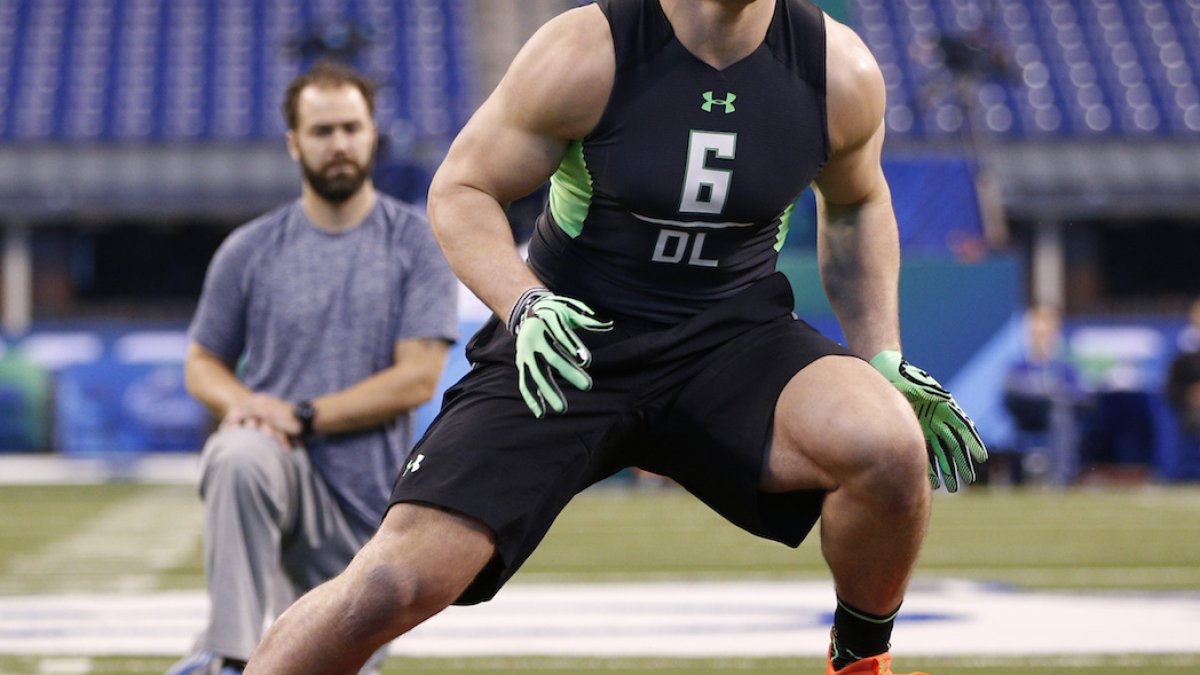The NFL scouting combine drills kick off later this week in Indianapolis, and with them comes a whole new set of data to analyze. What do the results of these drills really mean, though? Let’s examine all the events, the positions they matter the most to, and how that translates to the NFL.
40-yard dash
The sexiest drill of all, the 40-yard dash grabs the headlines, and running a 4.4 gives you bragging rights for the rest of your life. The problem is that only a few positions will regularly run 40 yards in a straight line on a football field. Wideouts, tight ends, safeties, and cornerbacks are the most common, and to those positions, the drill has legitimate value. Slow corners can’t make up ground if they lose it, and slow receivers have to be superb route-runners to separate downfield. Obviously speed matters to numerous other positions, but it doesn’t carry nearly the weight.
3-cone drill
The 3-cone drill is the real MVP of the NFL combine. A slow 3-cone is the kiss of death for almost every position besides offensive line in the NFL. Why, you ask? Because the ability to turn and accelerate quickly and efficiently is one of the key tenets of football. It’s a defensive end turning the corner on a tackle, a safety breaking on a corner route, and a running back cutting upfield. Unsurprisingly, Pittsburgh's Le’Veon Bell ran the 11th-best 3-cone of any running back in the past 10 years, at 6.75 seconds, and he was the only back among the top 30 to weigh over 220 pounds (he was 230). Cornerback Darrelle Revis ran a 6.56 cone at 204 pounds back at his pro day in 2007. If I had to pick one drill to look at, it’s this one.
20-yard shuttle
The shuttle can be used in tandem with the 3-cone drill under the umbrella of change-of-direction skills. Their combined percentile can give one a good picture of how well a guy plays in space.
225-pound bench press
Putting up 30 reps on the bench looks sick at your local gym, but truthfully, there’s not a huge translation to the NFL. The reason being that it doesn’t quite measure functional football strength effectively. Core and length strength is far more important in the NFL than chest and triceps. Obviously outliers on either end of the spectrum should be examined, but even then, it’s rarely a deal-breaker. Bears center Cody Whitehair put up 16 reps last year, the lowest of any offensive lineman at the combine, and then became the sixth-highest-graded center in the league as a rookie.
What a season by Cody @WhItehair76!!! pic.twitter.com/7hkqM9qcHG
— PFF (@PFF) February 15, 2017
Vertical jump and broad jump
While it’s not technically its own drill, I put these together because they measure the same thing: explosiveness. While it’s not technically its own drill, the 10-yard split of the 40-yard dash could also be placed in this category, as it measures the same thing. Truthfully these drills have application to nearly every position on the football field. One shouldn’t be surprised to know that Arizona's David Johnson and Miami's Jay Ajayi recorded 41.5-inch and 39-inch verticals, respectively, the way they shed through arm tackles. Same with Khalil Mack’s 10’8” and Von Miller’s 10’6” marks in the broad jump, given the way they burst off the line of scrimmage. Explosion equals good things no matter who you are.
60-yard shuttle
Few players even choose to participate in this drill, and, truthfully I don’t even look at it.
Body measurements
Out of every number recorded at the combine, these probably take more players off of draft boards than any other. Arm length for offensive tackles is the most widely publicized of the positional requirements. Short-armed tackles in college become guards in the NFL. Teams also have height cutoffs that exist for a handful of positions, most notably cornerback. And who can forget this time a year ago when everyone was obsessed with the hand size of NFL quarterbacks (though small hands do lead to more fumbles). Remember to stretch out your shoulders and massage those hands, everybody.



 © 2024 PFF - all rights reserved.
© 2024 PFF - all rights reserved.